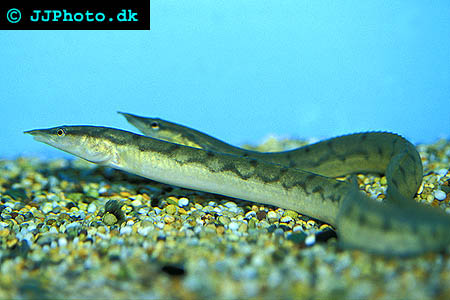Tiretrack Eels
Species name: Mastacembelus armatus
Synonym: None
Common name: Tiretrack eel, marbled eel, zigzag eel, spiny eel
Family: Mastacembelidae
Order: Synbranchiformes
Class: Actinopterygii
Maximum size: 36 inches (90cm)
Environment: Freshwater. Can tolerate brackish short term, but freshwater is ideal.
Origin: Southeast Asia
Temperament: Semi-aggressive when settled in.
Company: Fish too large to be eaten whole are generally safe. Its small size allows for many species to do well with this eel. However, it can become somewhat nippy even to fish too large to be eaten when it is not kept well fed. Fish that will bother the eel should be avoided. This includes aggressive cichlids and territorial bottom feeders.
Water parameters: pH: 6.5-7.5 ideal. Temperature: 72-83 Fahrenheit (22-28 Celsius).
Aquarium setup: A large tank with ample bottom area is needed for this large and somewhat active species. Many hides will be greatly appreciated. Stable rock piles, driftwood, PVC connectors and other things can fulfill this need. A tight-fitting cover is a must as this species will find and exploit even the smallest escape opportunities.
Tiretrack eel feeding: Naturally a carnivore feeding on many small invertebrates and small vertebrates, this species will accept an array of meaty foods. Some may need to be started on live foods such as black worms. Getting them on to a high quality pellet should be the goal. Live foods can introduce pathogens, increase aggression, and are nutritionally incomplete. Frozen foods may need to be an intermediate food during transition. Feeding from a bowl can help with transitioning them over to pellets.
Tiretrack eel breeding: Completely unknown except that they are egg-layers. Most likely the usual triggers that simulate the natural onset of the rainy season would be needed (decrease in temperature, change in photoperiod, increase food supply, etc.). Sexing is unknown. Females most likely plumper than males and may be larger.
I have had my tiretrack eel for about 9 months as of the writing of this article. I got it at about 6” and it is now about 20”. I never fed anything but New Life Spectrum out of a bowl. Mine has become somewhat nippy lately. It seems to not be too bad if I keep the tank well fed. I have found bite marks (unique mouth shape makes identifying the perpetrator easy) on spotted silver dollars, Synodontis eupterus, and even 3-5” Oscars. I have had unknown deaths that had been scavenged and discolored too much to tell if the tiretrack eel was at all to blame. I believe the eel had something to do with at least some of them.
This seems to be a somewhat intelligent species. It is highly reactive to the keeper. I used an under gravel filter riser tube to put the sinking pellets in the feeding bowl. It would be the first to the bowl (even before the food was in the water). I would wait for all the food to get to the bottom before lifting the tube, releasing the food into the bowl. It would stick its thin snout under the end of the tube and tap the tube up, releasing pellets that it would quickly suck up.

Tiretrack eels
Didn't find the info you were looking for? Register for free and ask your question in our Aquarium forum !
Our knowledgeable staff usually responds to any question within 24 hours
Related Articles
Australian Rainbow fish - Breeding and raising the Australian Rainbow fish, Pseudomugil gertrudae and Pseudomugil signifer.Breeding Chapalichthys pardalis - These goodeids are easy to breed, and they leave their young alone.
Breeding the Sailfin Goodeid - Girardinichthis viviparous - How to breed this seldom seen and difficult fish.
Clown Loaches - how to keep, breed and feed clown loaches
Coelacanths - A comprehensive overview of Coelacanths - The fish time forgot.
Minnows - An article about the group of fish called Minnows
Peacock Eels - An introduction to Peacock eels
Rainbowfish - An introduction to Rainbowfish
Rainbow fish Problems? - Read This - Dave points out that diet is the most important factor in keeping them healthy.
Red Belly Pacu - Information about Red Belly Pacu
Red tail sharks and their native home - An article about keeping Red tail sharks in aquariums and about their native home.
Sand Loaches - Breeding an inexpensive but uncommon loach, Acanthocobitis uropthalmus.
Scatophagus argus - How to treat their water, acclimatise them to fresh water, and feed them
spawning Chinese algae-eater (Gyrinocheilus aymonieri) - An account of an accidental spawning
Fish News
Aquarium Forum
Calculators
Free Aquarium Ebook
Feedback
Fish Anatomy
Link to us
Photo gallery
Plant species
Tropical fish species
By Common name
By Scientific name
Tropical Marine fish
By Common name
By Scientific name
Algae Control
Aquarium Decoration
Aquarium Resources
Aquatic Plants
Barb Fish
Betta Fish
Breeding Fish
Catfish
Central American Cichlids
Cichlids
Clownfish
Corals
Corydoras Catfish
Discus Fish
Dwarf Cichlids
Fish Diseases
Frogs and Turtles
Goby Fish
Goldfish
Gourami
Invertebrates
Jellyfish
Killiefish
Lake Victoria Cichlids
Livebearers
Malawi Cichlids
Marine Aquariums
Marine Aquarium Fish
Other Fish
Pleco
Predatory Fish
Photography
Pond Fish
Responsible Fish Keeping
Rainbow Fish
Shark Fish
South American Cichlids
Tanganyika Cichlids
Tetra Fish
Tropical Fish Food
